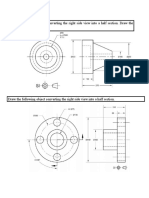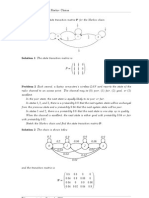Candles
Candles
Uploaded by
Gregor SamsaCopyright:
Available Formats
Candles
Candles
Uploaded by
Gregor SamsaOriginal Description:
Copyright
Available Formats
Share this document
Did you find this document useful?
Is this content inappropriate?
Copyright:
Available Formats
Candles
Candles
Uploaded by
Gregor SamsaCopyright:
Available Formats
1
Contents:
Standard
candles
What is a 'Standard Candle'?
Measuring distance using standard candles
Types of standard candle:
1. Cepheid variables
2. Type 1A supernovae
What is a 'standard candle'?
In astronomy, a standard candle is a source that has a known luminosity.
luminosity = total power output, measured in watts (W) or solar luminosities (L).
1 L = 3.84 x 1026 W
Measuring distance using standard candles
For distances which are too large to measure using parallax, astronomers use 'standard candles'.
Light sources which are further away appear fainter because the light is spread out over a greater area.
If we know how luminous a source really is, then we can estimate its distance from how bright it
appears from Earth.
The light which reaches Earth has
spread out over a sphere.
radius of sphere = distance to earth, r
Source of luminosity L
Surface area of sphere = 4r2
r
Earth
On Earth, the received power per unit
area is then
received power = source luminosity
per unit area
area of sphere
F=
L
4r2
The larger the distance, the smaller the power that we measure.
Astronomers traditionally measure the received power per unit area in magnitudes, but watts
per square metre (W/m2) is also good.
Dr Jennifer Hatchell
Types of standard candle
There are several types of 'standard candle' objects for which we can predict the luminosity from some
other measurement. Two of the most important are Cepheid variable stars and type 1A supernovae.
1. Cepheid variables
Cepheid variables are a special type of star with a luminosity which varies on a regular cycle. Around
1908, Henrietta Leavitt discovered that the period of the variability was closely linked to the luminosity
of the star.
So, if you time the variability of a Cepheid then you can predict its luminosity. And if you know its
luminosity and how bright it appears from Earth, then you can calculate the distance.
Cepheids are used to measure the distance of galaxies out to about 30,000,000 parsecs (30 Mpc).
Cepheids are what Edwin Hubble used to determine the distances of nebulae (ie. galaxies) and
derive the Hubble law.
2. Type 1A supernovae
Supernovae occur when massive stars explode at the end of their lives. A
white dwarf star in a binary pair with a red dwarf star steals mass from the
red dwarf until it is too massive to support itself against gravity any more.
Then its core collapses, starting a runaway nuclear reaction and a bright
explosion. Because the collapse always happens at the same mass, the
luminosity of the explosion is always the same. From this known
luminosity we can estimate the distance.
Supernovae are very bright often as bright as all the stars in a whole
galaxy put together. Because they are so bright, we can see them at very
great distances, up to around 10,000,000,000 parsecs.
The disadvantage of supernovae as standard candles is that they don't
hang around - you have to spot them when they go off, or shortly
afterwards.
Dr Jennifer Hatchell
You might also like
- List of Bondage PositionsDocument2 pagesList of Bondage PositionsGregor Samsa50% (8)
- AQA Physics Equation Sheet Triple Oct 19Document3 pagesAQA Physics Equation Sheet Triple Oct 19Ricky JacobNo ratings yet
- Limits (BDSM)Document3 pagesLimits (BDSM)Gregor Samsa43% (7)
- Albedo and Black Body Ib Practice Qs MarkschemeDocument8 pagesAlbedo and Black Body Ib Practice Qs MarkschemeInés Martínez MarchánNo ratings yet
- A Level Physics Standing WavesDocument5 pagesA Level Physics Standing Wavesaby251188No ratings yet
- Ib Physics - Unit 1 - Science SkillsDocument58 pagesIb Physics - Unit 1 - Science SkillsSaketh VuppalapatiNo ratings yet
- Linear Momentum ProblemsDocument11 pagesLinear Momentum ProblemsJoshuandy JusufNo ratings yet
- Cepheid Variables: Determining Distances To GalaxiesDocument4 pagesCepheid Variables: Determining Distances To GalaxiesGregor SamsaNo ratings yet
- AutofellatioDocument6 pagesAutofellatioGregor Samsa67% (3)
- AnilingusDocument5 pagesAnilingusGregor SamsaNo ratings yet
- Elizabeth Young Bruehl - Hannah Arendt's StorytellingDocument9 pagesElizabeth Young Bruehl - Hannah Arendt's StorytellingartanoNo ratings yet
- TLMaths A-Level Maths Playlist TrackerDocument54 pagesTLMaths A-Level Maths Playlist Trackerwill hayNo ratings yet
- BS UNIT 2 Normal Distribution NewDocument41 pagesBS UNIT 2 Normal Distribution NewSherona ReidNo ratings yet
- Understanding Total Internal Reflection of LightDocument21 pagesUnderstanding Total Internal Reflection of LightSiti Arbaiyah AhmadNo ratings yet
- Statistics 1 AQA Revision NotesDocument7 pagesStatistics 1 AQA Revision NotesShiv Kumar SinghNo ratings yet
- 14 - Waves General Waves and Wave Intensity - 14Document4 pages14 - Waves General Waves and Wave Intensity - 14dil19860209No ratings yet
- Ch. 5 Circular MotionDocument20 pagesCh. 5 Circular MotionTreeiciclesNo ratings yet
- CIE PhysicsDocument14 pagesCIE PhysicsengrroyNo ratings yet
- Separating MixturesDocument6 pagesSeparating MixturesKylie AlmarezNo ratings yet
- MockB HL P2 2015v1 Sect A OnlyDocument11 pagesMockB HL P2 2015v1 Sect A OnlyDhruvin DoshiNo ratings yet
- Lec 8 (MTH100) Matrices and DeterminesDocument9 pagesLec 8 (MTH100) Matrices and Determinesswatkhan3958No ratings yet
- Physics As - Unit 2 - Revision NotesDocument0 pagesPhysics As - Unit 2 - Revision NotesRimaz RameezNo ratings yet
- Surface Area of A PyramidDocument4 pagesSurface Area of A PyramidCharl Henley Q. AvilaNo ratings yet
- Vector Worksheet 10 AnsDocument13 pagesVector Worksheet 10 AnsMegan GohNo ratings yet
- Em 18 Equilibrium of A ParticleDocument2 pagesEm 18 Equilibrium of A ParticleFattihi EkhmalNo ratings yet
- Heat Notes A LevelDocument47 pagesHeat Notes A LevelEd Molson100% (1)
- Math 8 Study GuideDocument2 pagesMath 8 Study Guideapi-353567032No ratings yet
- Diffraction (Structured) QP 1Document7 pagesDiffraction (Structured) QP 1jean lamarNo ratings yet
- Permutation and Combination PDFDocument10 pagesPermutation and Combination PDFBinoy PaulNo ratings yet
- Trigonometry - Circles, Arcs & Sectors: IB Mathematics: Analysis & ApproachesDocument3 pagesTrigonometry - Circles, Arcs & Sectors: IB Mathematics: Analysis & Approachesbobby213No ratings yet
- Chapter 2, Linear Motion (Sec. 1)Document23 pagesChapter 2, Linear Motion (Sec. 1)FullyFaltooNo ratings yet
- A Level H2 Math Tampines Meridian JC1 Promo 2020iDocument30 pagesA Level H2 Math Tampines Meridian JC1 Promo 2020iTimothy HandokoNo ratings yet
- A Level Mathematics - Practice Paper - 7.4 - Differentiation in ContextDocument9 pagesA Level Mathematics - Practice Paper - 7.4 - Differentiation in ContextZaka AhmedNo ratings yet
- 9702 w17 QP 13 PDFDocument20 pages9702 w17 QP 13 PDFDhito PramudyaNo ratings yet
- Converting Repeating Decimals To FractionsDocument2 pagesConverting Repeating Decimals To FractionsLiezl AclanNo ratings yet
- 2023 N (A) 4045 (E-Math) (Analysis)Document24 pages2023 N (A) 4045 (E-Math) (Analysis)lohbernard168No ratings yet
- Math AA HL Optimization HL QuestionsDocument10 pagesMath AA HL Optimization HL QuestionssargkisianNo ratings yet
- 9630 PH01 International As Physics Specimen Paper 2016 v2Document24 pages9630 PH01 International As Physics Specimen Paper 2016 v2Antonius Ari SudanaNo ratings yet
- Igcse 15 TheturningeffectofforcesDocument23 pagesIgcse 15 TheturningeffectofforcesHany ElGezawyNo ratings yet
- Ib Magnetism - AllDocument14 pagesIb Magnetism - AllAarav VermaNo ratings yet
- Quadratic EquationDocument1 pageQuadratic EquationEmyRaNo ratings yet
- Atomic Physics CIE iGCSE 0625 PPQDocument11 pagesAtomic Physics CIE iGCSE 0625 PPQchelseaNo ratings yet
- AS Physics Topic Wise Questions: ForcesDocument17 pagesAS Physics Topic Wise Questions: ForcesAryan KingerNo ratings yet
- Gravitation Tutorial and Sol Q1 To 8 OnlyDocument11 pagesGravitation Tutorial and Sol Q1 To 8 OnlyJarrell YappNo ratings yet
- P3 Topical PastpapersDocument73 pagesP3 Topical PastpapersNdanji SiameNo ratings yet
- AP GP SummaryDocument21 pagesAP GP SummaryPng Poh ShengNo ratings yet
- States of Matter PresentationDocument16 pagesStates of Matter PresentationSherwin Kim CastanoNo ratings yet
- Moments ExtensionDocument1 pageMoments ExtensionTan Suk WanNo ratings yet
- Ib HL Counting Binomial QuestionsDocument2 pagesIb HL Counting Binomial QuestionsMohd Uvais100% (1)
- Phys 1121 Kinematic NotesDocument17 pagesPhys 1121 Kinematic NoteshardkntNo ratings yet
- FreeExamPapers.comDocument8 pagesFreeExamPapers.comHitechSoft HitsoftNo ratings yet
- MDM4U NOTES Week 5Document16 pagesMDM4U NOTES Week 5Nathan BittnerNo ratings yet
- A Level Work Energy PowerDocument17 pagesA Level Work Energy PowerHuurun AinNo ratings yet
- Finding Average & Significant FiguresDocument16 pagesFinding Average & Significant FiguresPraphul MalolNo ratings yet
- Specimen (IAL) QP - Unit 2 Edexcel Physics A-LevelDocument28 pagesSpecimen (IAL) QP - Unit 2 Edexcel Physics A-LevelAnadi RanjanNo ratings yet
- ADocument20 pagesAShu85No ratings yet
- Pound - Interest InvestigationDocument7 pagesPound - Interest InvestigationNatalia FilipowiczNo ratings yet
- Deformation of Solids Worksheet RealDocument13 pagesDeformation of Solids Worksheet RealPercy Carlos KasambiraNo ratings yet
- Aqa Physics 2 Revision NotesDocument66 pagesAqa Physics 2 Revision NotesAsif UllahNo ratings yet
- Practice Makes Perfect in Geometry: Three-Dimensional Figures with AnswersFrom EverandPractice Makes Perfect in Geometry: Three-Dimensional Figures with AnswersNo ratings yet
- CandlesDocument2 pagesCandlesMamaNo ratings yet
- Astronomy and Cosmology PresentationDocument31 pagesAstronomy and Cosmology PresentationKannan 20No ratings yet
- Cosmic Distance LadderDocument18 pagesCosmic Distance LadderGregor SamsaNo ratings yet
- Cosmic Distance LadderDocument18 pagesCosmic Distance LadderGregor SamsaNo ratings yet
- Absolute MagnitudeDocument14 pagesAbsolute MagnitudeGregor SamsaNo ratings yet
- Cepheid Variable Stars Navigation SearchDocument11 pagesCepheid Variable Stars Navigation SearchGregor SamsaNo ratings yet
- PulseDocument10 pagesPulseGregor SamsaNo ratings yet
- Redefining RodiniaDocument7 pagesRedefining RodiniaGregor Samsa100% (1)
- The Proterozoic Supercontinent RodiniaDocument12 pagesThe Proterozoic Supercontinent RodiniaGregor SamsaNo ratings yet
- Outline of BDSMDocument8 pagesOutline of BDSMGregor Samsa33% (3)
- Measuring Distance With CepheidsDocument10 pagesMeasuring Distance With CepheidsGregor SamsaNo ratings yet
- Billion: HistoryDocument3 pagesBillion: HistoryGregor SamsaNo ratings yet
- Cléo DuboisDocument3 pagesCléo DuboisGregor SamsaNo ratings yet
- BottomDocument4 pagesBottomGregor SamsaNo ratings yet
- ChastityDocument4 pagesChastityGregor SamsaNo ratings yet
- Sex PositionsDocument15 pagesSex PositionsGregor Samsa0% (1)
- Portacable y EnrolladorDocument1 pagePortacable y EnrolladorGregor SamsaNo ratings yet
- HABEGGER-Accessories: Safety Load HookDocument1 pageHABEGGER-Accessories: Safety Load HookGregor SamsaNo ratings yet
- Manual de Sap2000 1Document94 pagesManual de Sap2000 1miguelaseNo ratings yet
- WeldingDocument3 pagesWeldingGregor SamsaNo ratings yet
- Project in Industrial ArtsDocument2 pagesProject in Industrial ArtsGlyzah Pama100% (3)
- RPH 2 EMERALD (DLP) Sel, Rab, JematDocument132 pagesRPH 2 EMERALD (DLP) Sel, Rab, JematNisa ADNo ratings yet
- IT ManagerDocument2 pagesIT ManagerRuppee EdwardNo ratings yet
- How To Become A Successful Language LearnerDocument9 pagesHow To Become A Successful Language LearnerNadia KniftonNo ratings yet
- Americae Sive Qvartae Orbis Partis Nova Et Exactissima Descriptio Library of CongressDocument1 pageAmericae Sive Qvartae Orbis Partis Nova Et Exactissima Descriptio Library of Congresssalmamourad2313No ratings yet
- The Speaking ModelDocument2 pagesThe Speaking ModelIonuț CăpeneațăNo ratings yet
- Post Graduate - 17 November 2015Document20 pagesPost Graduate - 17 November 2015Times MediaNo ratings yet
- Draw The Following Object Converting The Right Side View Into A Half Section. Draw The Appropriate Cutting Plane LineDocument2 pagesDraw The Following Object Converting The Right Side View Into A Half Section. Draw The Appropriate Cutting Plane LineAliceAlormenuNo ratings yet
- Correlation and RegressionDocument81 pagesCorrelation and RegressionMridul MalikNo ratings yet
- Movingand GrowingDocument1 pageMovingand GrowingCarolyne AchiengNo ratings yet
- EMILE DURKHEIM The Elementary Forms of The Religious LifeDocument32 pagesEMILE DURKHEIM The Elementary Forms of The Religious Lifeapi-3769712No ratings yet
- DLP Sci 7 4QTR W3 D4Document3 pagesDLP Sci 7 4QTR W3 D4Cresta-lyn MolandaNo ratings yet
- Color Distribution of A Shade Guide in The Value, Chroma, and Hue ScaleDocument11 pagesColor Distribution of A Shade Guide in The Value, Chroma, and Hue ScaleHarmath ZsofiaNo ratings yet
- Sae Technical Paper Series: Matthew B. ParkinsonDocument14 pagesSae Technical Paper Series: Matthew B. ParkinsonManjunath YaraguppiNo ratings yet
- Apical Gauging - SeniaDocument3 pagesApical Gauging - Seniahafizhuddin muhammadNo ratings yet
- Diary of Anne Frank EssayDocument5 pagesDiary of Anne Frank Essayafibykkhxxhdid100% (2)
- Exercise On Stress in 2 Syllable WordsDocument18 pagesExercise On Stress in 2 Syllable WordsPham Ba Dat100% (2)
- KAI BrochureDocument2 pagesKAI BrochureErwin Dela CruzNo ratings yet
- Research Methods & Techniques (524) First Assignment: Ejaz Alam Khan - H 5279752Document23 pagesResearch Methods & Techniques (524) First Assignment: Ejaz Alam Khan - H 5279752NanaBearNo ratings yet
- 13a SAWARD 2010Document106 pages13a SAWARD 2010HannahMaruci0% (1)
- On Some Aspects of The Historiography of Colonial India (1982)Document4 pagesOn Some Aspects of The Historiography of Colonial India (1982)Piero Donnini ArezzoNo ratings yet
- Problems 2Document8 pagesProblems 2Qi Ming Chen100% (2)
- Organisational BehaviourDocument279 pagesOrganisational Behaviouranjanaindia3542100% (22)
- Remote SensingDocument27 pagesRemote Sensingmnry414No ratings yet
- 1 2 3 4 MergedDocument19 pages1 2 3 4 MergedRed SkullNo ratings yet
- Lord Kuthumi - 8:8:8 Lion's Gate 1 Prosperity Christ Grids Anchoring ChannellingDocument9 pagesLord Kuthumi - 8:8:8 Lion's Gate 1 Prosperity Christ Grids Anchoring ChannellingEmeraldRayNo ratings yet
- 06163389Document12 pages06163389sudhirkmnNo ratings yet
- Financial Research Correlation AnalysisDocument27 pagesFinancial Research Correlation Analysisisabe lle0% (1)
- Thrusts 1. The Future, 2. Uniqueness, 3. Sustainability, 4. Humanity, 5. Universality, 6. Change, 7. Sacrifice Guiding PrinciplesDocument6 pagesThrusts 1. The Future, 2. Uniqueness, 3. Sustainability, 4. Humanity, 5. Universality, 6. Change, 7. Sacrifice Guiding PrinciplesNoel KlNo ratings yet















































































































